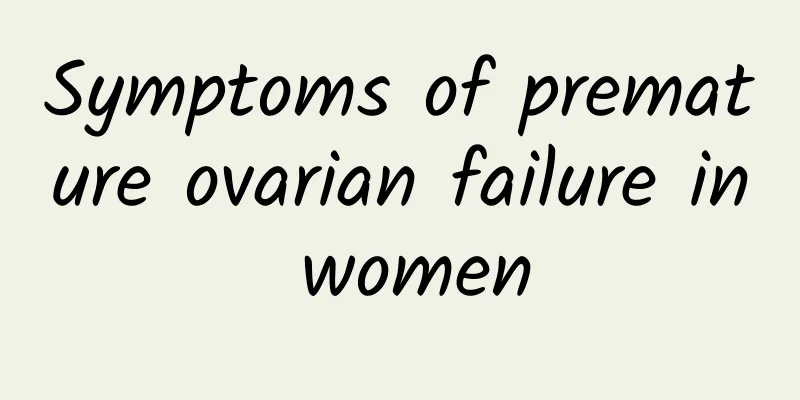Symptoms of premature ovarian failure in women

|
Women must be vigilant when their ovarian function declines. There are many hazards in ovarian function decline, so the ovaries should be maintained in time. So what are the symptoms of ovarian dysfunction? 1. Urinary tract symptoms Frequent urination, urgency, incontinence, or urinary retention are caused by atrophy of the urethra and bladder due to decreased estrogen. 2. Skin and hair symptoms The skin edges become thinner, lose elasticity, and wrinkles appear; skin pigmentation occurs, mostly on the face, back of the hands, and legs; hair gradually falls out and turns gray. 3. Psychiatric symptoms Worry, amnesia, inattention, irritability, insomnia, and even moodiness, especially in the past, the symptoms are more obvious in women with unstable mental states. 4. Reproductive tract changes Pain and difficulty in sexual intercourse; manifestations of senile vaginitis include vaginal burning sensation, yellow and smelly leucorrhea, and even blood; atrophy and closure of the cervical canal with uterine empyema; atrophy of the uterus and other reproductive organs. 5. Vasomotor syndrome Common symptoms include skin flushing, hot flashes, sweating, dizziness, etc. The most typical symptoms are hot flashes and sweating, which occur in paroxysmal frequency, several times or even dozens of times a day, and last for a few seconds to a few minutes. 6. Bone and joint symptoms Osteoporosis is the most important complication in postmenopausal women, manifested by pain in the neck, waist, back, shoulders, knees, and arms, and a significantly increased incidence of fractures, with common sites being the ribs, vertebrae, hips, limbs, and femoral neck. 7. Cardiovascular disease Menopausal hypertension is characterized by elevated systolic blood pressure and high fluctuations; or "pseudo-angina", often manifested as cramps, palpitations, paroxysmal tachycardia or bradycardia. Because estrogen can lower blood lipids and prevent vascular sclerosis, the incidence of hypertension and coronary heart disease in premenopausal women increases. 8. Menstrual disorders It can manifest in three forms: prolonged menstrual cycle or intermittent amenorrhea, reduced menstrual volume, shortened menstrual cycle, until menopause; or shortened menstrual cycle, frequent menstrual cycle, prolonged menstrual cycle, increased menstrual volume, and even heavy vaginal bleeding or spotting, and then gradually reduced to menopause; or sudden cessation of menstruation, which is less common. See. The above article introduces the symptoms of premature ovarian failure in women. I believe everyone knows that in life, once you find yourself having such symptoms, you should be more careful, seek medical attention in time, and avoid delays. |
<<: What are the factors that lead to premature ovarian failure?
>>: Foods that are good for premature ovarian failure
Recommend
Is it normal to have menstruation 15 days after uterine curettage?
Is it normal to have menstruation 15 days after u...
Cai Peiran’s mermaid line is 90 points! Sculpting without sweating
Recently, the keyword that has been trending on t...
4 Chinese medicine weight loss secrets for beauties that transcend age boundaries
[Key News Introduction]: Skinny beauties are in f...
How much do you know about the symptoms of ectopic pregnancy?
How much do you know about the symptoms of ectopi...
Can adnexitis cause constant abdominal pain?
Adnexitis may cause persistent abdominal pain, so...
Patients with pelvic inflammatory disease should promptly detect their symptoms
The occurrence of pelvic inflammatory disease wil...
Expert introduction: What are benign ovarian cysts?
We know that although benign ovarian cysts are a ...
Women should know the importance of precautions after abortion
There is a lot of publicity about abortion in our...
Which hospitals treat vaginitis?
Which hospitals can treat vaginitis? In recent ye...
What to do with irregular menstruation?
What should we do for irregular menstruation? It ...
Are there any traditional Chinese medicine granules for treating irregular menstruation?
Irregular menstruation is a common gynecological ...
What methods can be used to treat ovarian cysts?
Although ovarian cysts are not a common disease, ...
Does drinking brown sugar water have any effect on pelvic inflammatory disease?
Pelvic inflammatory disease refers to an inflamma...
How much do you know about the symptoms caused by ovarian cysts?
Ovarian cysts are a disease that has no obvious s...
Women should know clearly what the symptoms of ectopic pregnancy are
In our lives, ectopic pregnancy is very common, a...









